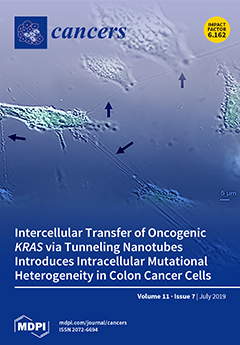The Wnt pathway is involved in the progression of breast cancer (BC). We aimed to evaluate the expression of some components of the Wnt pathway (β-catenin, FZD4 (frizzled receptor 4), LRP5 (low-density lipoprotein receptor-related protein 5), LRP6, and TCF1 (T-cell factor 1)) to
[...] Read more.
The Wnt pathway is involved in the progression of breast cancer (BC). We aimed to evaluate the expression of some components of the Wnt pathway (β-catenin, FZD4 (frizzled receptor 4), LRP5 (low-density lipoprotein receptor-related protein 5), LRP6, and TCF1 (T-cell factor 1)) to detect potential associations with NHERF1 (Na+/H+ exchanger regulatory factor 1) protein. Besides, we assessed their impact on patients’ clinical outcome. We evaluated 220 primary BC samples by immunohistochemistry (IHC) and protein localization by immunofluorescence. We found a significant correlation between NHERF1 and FZD4, LRP5, LRP6, and TCF1. Univariate analysis showed that the overexpression of β-catenin (
p < 0.0001), FZD4 (
p = 0.0001), LRP5, LRP6, and TCF1 (
p < 0.0001 respectively) was related to poor disease-free survival (DFS). A Kaplan-Meier analysis confirmed univariate data and showed a poor DFS for cNHERF1+/FZD4+ (
p = 0.0007), cNHERF1+/LRP5+ (
p = 0.0002), cNHERF1+/LRP6+ (
p < 0.0001), and cNHERF1+/TCF1+ phenotypes (
p = 0.0034). In multivariate analysis, the expression of TCF1 and β-catenin was an independent prognostic variable of worse DFS (
p = 0.009 and
p = 0.027, respectively). In conclusion, we found that the overexpression of β-catenin, FZD4, LRP5, LRP6, and TCF1 was associated with poor prognosis. Furthermore, we first identified TCF1 as an independent prognostic factor of poor outcome, indicating it as a new potential biomarker for the management of BC patients. Also, the expression of Wnt pathway proteins, both alone and in association with NHERF1, suggests original associations of biological significance for new studies.
Full article






